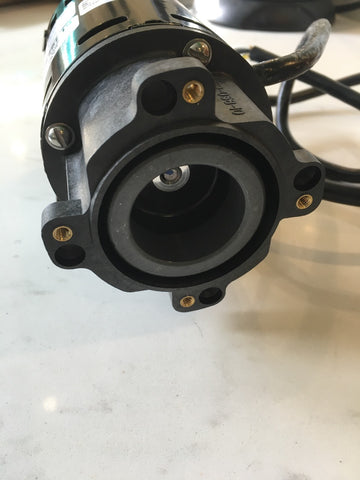Troubleshooting the March 815
For troubleshooting your March 815, check the following things:
- Ensure the correct power is available to the pump (120V in North America).
- When powered on, inspect the fan (opposite side of the 815 head) to ensure it rotates freely. The fan moves in the same direction as the impeller which should be in a counter-clockwise direction (when facing the impeller side of the 815) to drive liquid out the exit port. If it is turning in a clockwise direction, it means the impeller will be pushing liquid in the 'wrong' direction. To correct this, an electrician can reverse the wires to the motor to cause it to spin in the correct direction. If the impeller does not spin at all, unplug the 815 immediately as the impeller is likely jammed or misaligned and needs to be inspected (see step 4).
- Inspect the lines leading to the 815 and returning to your vessel to ensure they are open, and full of free flowing liquid (water, wort or beer). A quick way to inspect to see if it is free flowing is to remove the distil (far) end of the return hose that is connected to the Mash Colander (or fermenter) and lower it until it is below the liquid level in the fermenter—liquid should passively flow out of the hose under the 'push' of gravity. If it does not, this likely means there is blockage somewhere in the line. Blockage could be at the start of the line (the exit port of the fermenter) which can be checked by removing the 815 return hose connection and inspecting for blockage—or it could be in the return line, likely at the valve leading back into the vessel. If the line is not blocked, but liquid won't flow through, it could be blockage inside the 815 head.
- If the 815 fan and impeller are not moving, or liquid will not freely flow through the 815 head, the head should be disassembled and inspected using the following steps.
| 1. Remove the screws holding the head cover plate in place. |  |
 |
2. Remove the impeller housing. |
| 3. Turn the motor on and off again and ensure the magnet driving the impeller freely spins. |  |
 |
4. Remove the back plate from the 815 head that holds the impeller in place. |
| 5. Inspect the 815 head for debris or soil that may impede the impeller from freely spinning on the central shaft. |  |
 |
6. Remove the impeller and inspect for malt or soil that may impede free movement. |
| 7. Reinstall the housing, impeller, white shaft gasket (if it falls off), impeller plate gasket, and 815 head. |  |
In response to a question on decoupling of the impeller and drive magnets our March rep had this to say:
Generally decoupling occurs (in order of likelihood) as a result of:
- Liquid specific gravity and/or viscosity relative to the impeller diameter. Overwhelmingly, across all industries we service, this is the primary cause. You’ve seen on our curves that we have different impeller diameters for different liquid specific gravities. The magnetic field that turns the impeller is only so strong and, when an impeller’s vanes are too long for the viscosity or SG of the liquid, the field is not strong enough to overcome impeller resistance at start-up and maintain the same RPM as the drive magnet. Once the drive magnet and motor are turning without the impeller, it will never ‘re-catch’ or recouple without shutting the 815 off. Of course, if the viscosity/SG of the liquid remains the same, it will usually repeat this failure at start-up. However, wort never really approaches SG anywhere near 1.1-1.2, which is where the potential for decoupling in the 815 with a full-sized impeller would exist.
- Suspended solids in a solution – sometimes guys will use our 815 and try to pass a concentration of solids through the 815. Those solids can build up between the rear housing and the back of the impeller and cause decoupling; likewise, an impassable solid flowing through the 815 could conceivably offer enough resistance upon impact with the impeller vanes to decouple it.
- Prolonged operation while demagnetized – if a user lets a 815 run for a long period of time while decoupled, it can weaken (through demagnetization) the magnets and lower their ability to maintain the torque required to turn the impeller.
- Parts swell at boiling (or near boiling) temperatures – though I haven’t encountered this, in discussing this with Walter today, it seems plausible considering the ‘drilling-out’ conversation we’ve been having. If the impeller expands slightly with heat, it could conceivably create enough resistance spinning against the shaft to cause decoupling, though again I don’t believe we have experienced this cause in any actual case.
As long as no other damage occurs, in all cases except 3, once the cause is identified and amended a re-start of the 815 should result in normal start-up and pumping.
In the case of the low head output (a low flow leaving the 815) chances are it is related to how a customer is using it (low inlet flows, air intake, line obstruction, etc.).
For more troubleshoot advice, consult the March website.